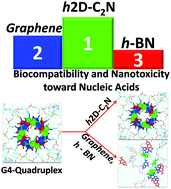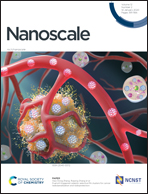Screening two dimensional materials for the transportation and delivery of diverse genetic materials†
Abstract
In spite of several reports of graphene and other 2D materials concerning their capacity for biomolecular adsorption and delivery, recent toxicity evaluations found them to be nanotoxic toward different biomolecules, especially nucleic acids. Therefore, there is urgent demand for the synthesis of 2D materials exhibiting biocompatible and non-nanotoxic features. In this article, employing classical molecular dynamics simulations, we provide a benchmarking of h2D-C2N, graphene and hexagonal boron nitride (h-BN) toward the adsorption, preservation, targeting and delivery of various classes of nucleic acids namely single stranded DNA, double stranded natural as well as unnatural base substituted DNA and two different types of human telomeric guanine quadruplexes, all comprising different secondary structures. Our simulations reveal that, while h2D-C2N preserves the structures of most of the nucleic acids, graphene and h-BN disrupt them through strong π–π stacking with aromatic nucleobases. Interestingly, for the first time we identified a ‘quartet-by-quartet’ disruption mechanism of guanine quadruplexes, but only on graphene and h-BN. The lateral diffusion of adsorbed nucleic acids over C2N is restricted unlike that over both graphene and h-BN, thereby increasing the targeting efficacy for C2N. Modeling of the delivery phenomena suggests orders of magnitude longer release times from graphene and h-BN compared to C2N, thereby demonstrating the preferential suitability of C2N for all the hierarchical steps of nucleic acid transportation.



 Please wait while we load your content...
Please wait while we load your content...